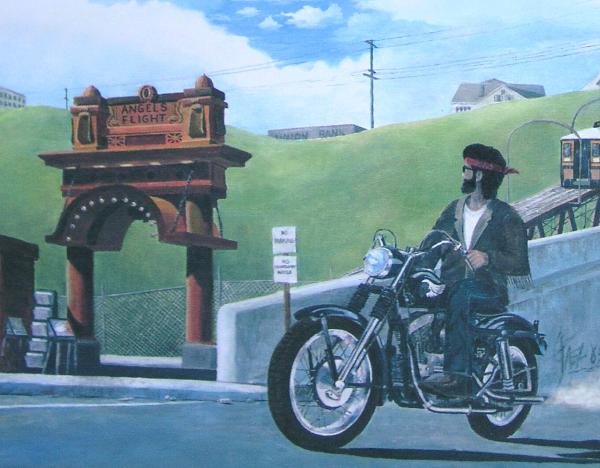
Cover Detail
Front Flap
Back Flap
* A headspinning, sometimes shocking adventure through fifty of the most turbulent years in history -- featuring an unforget- table cast of characters * All the familiar names are here -- all the key decisions * You'll savor the nostalgia and be amazed at what was not reported * Did America make fatal mistakes after WWII? * What are the implications for our future? * A witty, sexy, thought-provoking page-turner Cover painting by Douglas Castleman www.DougNCart.com |
Originally from a small town in East Texas, Milt Timmons started as a professional child actor, then moved to Los Angeles for graduate degrees from UCLA and USC. During thirty years as a Cinema professor in Hollywood, he wrote several scholarly books, plus many scripts, stories, and articles. This is his first novel. |
Product Description
“Regarding an Angel’s Flight” is a philosophical and psychological study of changing American morals
and mores over the last half century - structured, in the classical tradition of “Hamlet” and “Oedipus
Rex,” as both murder mystery and tragedy. In essence, it falls within the “spiritual adventure” genre
that seems to be growing in popularity - but with an Existential twist.
After a series of mysterious murders in a small Southern town, a grad student suddenly finds himself
caught up in a twentieth century version of “Pilgrim’s Progress.” The story is a philosophical who-
done-it, as well as a search for morality within a high-tech world of conflicting ideologies.
Inspired by the philosophical novels of Aldous Huxley and Umberto Eco, it is designed for
sophisticated readers, ranging from college students to middle aged professionals, who demand more
from fiction than simple melodrama.
The book covers the period from 1933 (with the inaugurations of Franklin Roosevelt and Adolf Hitler)
to the reelection of Ronald Reagan in 1984. Emphasis is placed on both the tactics of terrorism and
the psychology of fascism in all its guises. News reports and analyses are used as transitions
between dramatic scenes - which serve the dual purpose of placing the fictional story in historical
context, while at the same time dramatizing the issues being played out on the world stage. Some
attention is also given to such cultural details as changing fashions in architecture, cars, clothing,
movies, books, songs, radio, TV, comics, slang, etc.
“Angels Flight” was the name of Los Angeles’ only cable car, built in 1900, and a favorite tourist
attraction until it was dismantled in 1969. During those years, it came to be regarded as a symbol of
Los Angeles, just as the Eiffel Tower symbolizes Paris, and the Statue of Liberty represents New York.
Much of the novel revolves around a souvenir medallion with an engraving of the two cars: “Sinai” and
“Olivetti.” “Mt. Sinai” and “The Mount of Olives” represent the two most important religious traditions
in the Western world (in opposition to each other); and as the cars alternately ascend and descend
like clockwork, they suggest the passage of time - as does a certain rotating restaurant which also
figures prominently in the plot.
Major Characters
Austin Adams - This is the protagonist. We follow his life from birth in 1933 to the climax of the book.
He is the only son of Barney and Ada Sue Adams.
Barney Adams - The Reverend Barnabus (Barney) Adams is an unschooled lay preacher at a small
Baptist church in Pinegrove, Texas. He makes his living as a house painter, but the church provides
him with a parsonage. He is the father of Austin, and husband of Ada Sue Adams.
Ada Sue Adams - A full-time mother and housewife. She has no outside interests other than church
work.
Daniel Jackson - A childhood friend of Austin, and the bane of Barney’s life. Dan is a charming and
highly intelligent prankster who delights in thumbing his nose at society. Eventually he upsets a few too
many people.
Freckles (Freck) Brandon - Austin’s closest childhood friend. He is a slightly chubby red-head, who
always takes a common sense view of things, and tries to keep Austin and Dan out of trouble. He
moves away at the end of chapter one, but adds a surprising twist to the plot many years later.
Elaine Thompson - A warm and pretty next door neighbor who grows up with Austin. They are
sweethearts throughout their school years and plan to marry after college, but fate decrees otherwise.
Sheila Fitzpatrick - A rich and neurotic beauty queen with whom Austin is smitten during his first year of
college. But she is a Catholic who delights in tormenting Austin because of his plans to become a
Baptist missionary.
Neils Olafson - A strange looking and mystical little man, who is a member of the Rosicrucian
Brotherhood. As a fellow electronics technician, he tries to help Austin adjust to life on the Naval Air
Station at Alameda, California.
Einar Slaveczk - An aircraft mechanic who also befriends Austin at NAS Alameda. He is a Gypsy
refugee who escaped from Hitler’s Germany, later to join the US Navy. He is a nihilistic alcoholic, whose
only interests are booze and broads.
Naomi Goldman - An apostate Jew, whose primary interest in Austin is strictly sexual. Austin has no
objection to this arrangement - at first.
Pierre Le Conte - A doctoral candidate in Physics at UC Berkeley. He is a foreign student from France
who shares an apartment with Naomi. They introduce Austin to the philosophy of Existentialism, and
the beatnik life-style.
Shinichi Yamamoto - A Japanese refugee from Hiroshima, and Zen master, who is a friend of Pierre and
Naomi - later to become a mentor to Austin.
Babs Walker - A pretty, but bubble-headed, cheer-leader who begins dating Austin when he returns to
college after his hitch in the Navy. She is a Christian Scientist who refuses medical treatment, even
after a severe injury during a race riot.
Delores King - A more intellectual, but frigid, classmate who begins dating Austin after his breakup with
Babs. Having been raised as a Presbyterian, she finds herself fighting chronic depression because of
her obsession with the doctrine of predestination. She and Austin begin publishing an underground
campus newspaper.
Professor Gustav (Gus) Eriksen - A rationalistic philosophy professor who hires Austin as his teaching
assistant. He also provides financing for the underground newspaper, and becomes a father-figure for
Austin. But the professor’s ideas are not very popular with the rural townsfolk during the tumultuous
days of forced integration.
Wally Matheson - A wheelchair-bound, former lawyer, who is manager of a rooming house on Bunker
Hill, when Austin first meets him. He helps Austin with his detective work in Los Angeles, and provides
some surprises during the denouement.
Bob LaGrange - A clinical psychologist who gave up his practice, to become manager of a nudist park
in the San Gabriel Mountains of Southern California.
Starfire - A hippie girl, who belongs to Wicca, and who introduces Austin to Marco Baba, and later
accompanies them to an orgiastic Black Mass.
Marco Baba - A preacher, and friend of Bob LaGrange, who conducts services for Wiccans,
Spiritualists, and other New Age groups.
Austin Adams - This is the protagonist. We follow his life from birth in 1933 to the climax of the book.
He is the only son of Barney and Ada Sue Adams.
Barney Adams - The Reverend Barnabus (Barney) Adams is an unschooled lay preacher at a small
Baptist church in Pinegrove, Texas. He makes his living as a house painter, but the church provides
him with a parsonage. He is the father of Austin, and husband of Ada Sue Adams.
Ada Sue Adams - A full-time mother and housewife. She has no outside interests other than church
work.
Daniel Jackson - A childhood friend of Austin, and the bane of Barney’s life. Dan is a charming and
highly intelligent prankster who delights in thumbing his nose at society. Eventually he upsets a few too
many people.
Freckles (Freck) Brandon - Austin’s closest childhood friend. He is a slightly chubby red-head, who
always takes a common sense view of things, and tries to keep Austin and Dan out of trouble. He
moves away at the end of chapter one, but adds a surprising twist to the plot many years later.
Elaine Thompson - A warm and pretty next door neighbor who grows up with Austin. They are
sweethearts throughout their school years and plan to marry after college, but fate decrees otherwise.
Sheila Fitzpatrick - A rich and neurotic beauty queen with whom Austin is smitten during his first year of
college. But she is a Catholic who delights in tormenting Austin because of his plans to become a
Baptist missionary.
Neils Olafson - A strange looking and mystical little man, who is a member of the Rosicrucian
Brotherhood. As a fellow electronics technician, he tries to help Austin adjust to life on the Naval Air
Station at Alameda, California.
Einar Slaveczk - An aircraft mechanic who also befriends Austin at NAS Alameda. He is a Gypsy
refugee who escaped from Hitler’s Germany, later to join the US Navy. He is a nihilistic alcoholic, whose
only interests are booze and broads.
Naomi Goldman - An apostate Jew, whose primary interest in Austin is strictly sexual. Austin has no
objection to this arrangement - at first.
Pierre Le Conte - A doctoral candidate in Physics at UC Berkeley. He is a foreign student from France
who shares an apartment with Naomi. They introduce Austin to the philosophy of Existentialism, and
the beatnik life-style.
Shinichi Yamamoto - A Japanese refugee from Hiroshima, and Zen master, who is a friend of Pierre and
Naomi - later to become a mentor to Austin.
Babs Walker - A pretty, but bubble-headed, cheer-leader who begins dating Austin when he returns to
college after his hitch in the Navy. She is a Christian Scientist who refuses medical treatment, even
after a severe injury during a race riot.
Delores King - A more intellectual, but frigid, classmate who begins dating Austin after his breakup with
Babs. Having been raised as a Presbyterian, she finds herself fighting chronic depression because of
her obsession with the doctrine of predestination. She and Austin begin publishing an underground
campus newspaper.
Professor Gustav (Gus) Eriksen - A rationalistic philosophy professor who hires Austin as his teaching
assistant. He also provides financing for the underground newspaper, and becomes a father-figure for
Austin. But the professor’s ideas are not very popular with the rural townsfolk during the tumultuous
days of forced integration.
Wally Matheson - A wheelchair-bound, former lawyer, who is manager of a rooming house on Bunker
Hill, when Austin first meets him. He helps Austin with his detective work in Los Angeles, and provides
some surprises during the denouement.
Bob LaGrange - A clinical psychologist who gave up his practice, to become manager of a nudist park
in the San Gabriel Mountains of Southern California.
Starfire - A hippie girl, who belongs to Wicca, and who introduces Austin to Marco Baba, and later
accompanies them to an orgiastic Black Mass.
Marco Baba - A preacher, and friend of Bob LaGrange, who conducts services for Wiccans,
Spiritualists, and other New Age groups.
Character Development
In character-driven fiction, such as this novel, I have developed a technique for creating realistic
characters by using a 44 page questionnaire, called a Character Analysis Form, which
consists of many personality measurement scales, developed by psychologists over the years.
Therefore, I know all about each character before I ever begin work on the actual narrative.
Two of the most important questions are what the character looks like, and who I can use as a
model for his or her personality. The following shows the characters in more detail.
In character-driven fiction, such as this novel, I have developed a technique for creating realistic
characters by using a 44 page questionnaire, called a Character Analysis Form, which
consists of many personality measurement scales, developed by psychologists over the years.
Therefore, I know all about each character before I ever begin work on the actual narrative.
Two of the most important questions are what the character looks like, and who I can use as a
model for his or her personality. The following shows the characters in more detail.
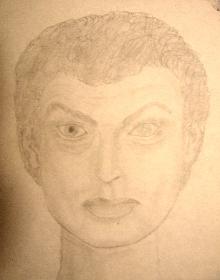
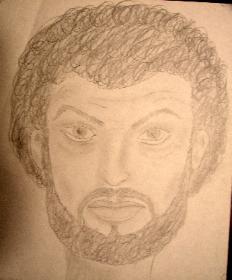
Note: There's
nothing wrong with
his left eye; that's
just an effect of the
flash photograph
of the sketch.
nothing wrong with
his left eye; that's
just an effect of the
flash photograph
of the sketch.
Hippie Austin
Young Austin
Austin's somewhat awkward and nervous mannerisms were modeled after the young
Anthony Perkins.
Anthony Perkins.
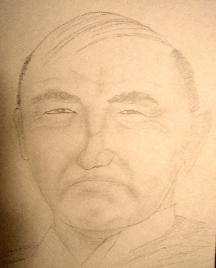
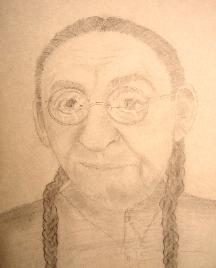
Barney and Ada
Sue were modeled
after an aunt and
uncle.
Sue were modeled
after an aunt and
uncle.
Barney Adams
Ada Sue Adams
Freck Brandon was modeled after a
childhood friend -- considerably modified.
childhood friend -- considerably modified.
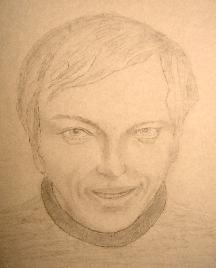
Elaine Thompson was modeled after a
high school sweetheart.
high school sweetheart.
Sheila Fitzpatrick was modeled after 19
year old Cybill Shepherd, as seen in The
Last Picture Show.
year old Cybill Shepherd, as seen in The
Last Picture Show.
Naomi Goldman was modeled after
Cher when she was in her mid-twenties.
Cher when she was in her mid-twenties.
Daniel Jackson was
modeled after a boyhood
friend.
modeled after a boyhood
friend.
Gus Eriksen was modeled after Spencer
Tracy in his mid-fifties, as he appeared in
Inherit the Wind.
Tracy in his mid-fifties, as he appeared in
Inherit the Wind.
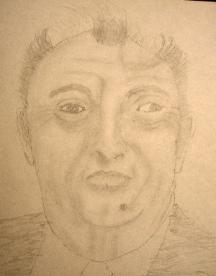
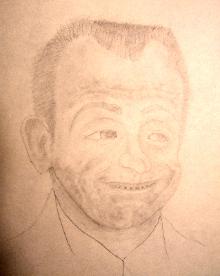
Einar Slaveczk was modeled
after a man I once met at a
writer's conference
after a man I once met at a
writer's conference
Neils Olafson was inspired
by a sailor I once met.
by a sailor I once met.
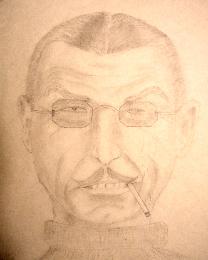
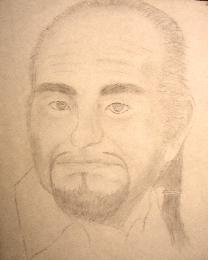
Pierre Le Conte was
based on a grad student I
once met in a Paris hostel.
based on a grad student I
once met in a Paris hostel.
Shinichi Yamamoto was a
purely fictitious character that
I created from scratch.
purely fictitious character that
I created from scratch.
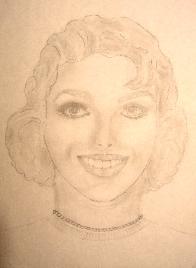

Babs Walker was
modeled after Judy Holliday
in mannerisms, but after a
former girlfriend in beliefs.
modeled after Judy Holliday
in mannerisms, but after a
former girlfriend in beliefs.
Delores King was modeled
after another former girlfriend,
considerably modified.
after another former girlfriend,
considerably modified.
Wally Matheson, Bob LaGrange, Starfire, and Marco Baba played such minor
parts that I did not make a complete analysis for each of them.
parts that I did not make a complete analysis for each of them.
Austin's house, the town of Pinegrove, and the campus of Pinegrove State Teachers
College did play large parts, however, so I thought them out very carefully.
College did play large parts, however, so I thought them out very carefully.
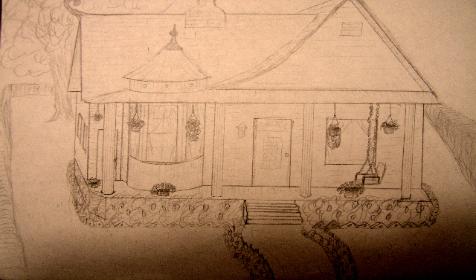
The Adams House

House Blueprints
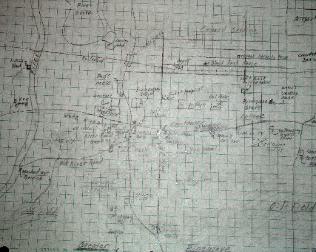
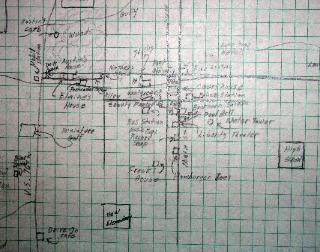
Map of Greater Pinegrove
Pinegrove Central Business District

Campus Map of Pinegrove State College
Reviews
For an interview with Milt,
conducted by Page One
PR company, click here
conducted by Page One
PR company, click here
Note: It has been suggested by several fans that this novel
contains so much important information that it should be
studied in high school and college literature classes. If any
teacher would like to use it for such purposes, please
contact me and I will be happy to provide a study guide.
contains so much important information that it should be
studied in high school and college literature classes. If any
teacher would like to use it for such purposes, please
contact me and I will be happy to provide a study guide.